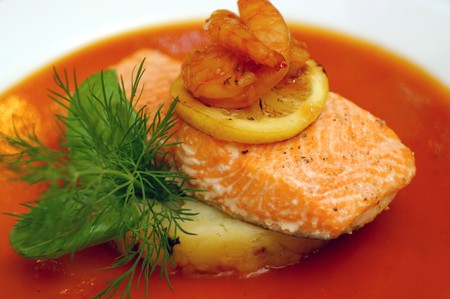Hungry Hieroglyphics Part 2

We can all eat a little better knowing what we put in our bodies. The same goes for knowing how things are cooked. Below is the second part of an article that gives you a better understanding of both. These words can be found on a menu of your local dining establishment and also on those cooking shows you try and snare ideas from. The more you know, the more you grow (at least that’s what NBC told me after its public service announcements.)
Demi-glace: The French have great ideas, and this is one where you reduce what is usually an even mix of brown stock (roasting chicken, beef or pork bones and making a stock) and brown sauce (brown stock thickened by a roux) by half. It’s packed with flavor because it’s usually concentrated.
Ganache: Desserts are the usual suspect involved with this mixture mad from chocolate, heavy cream and sometimes butter. This is a glaze, filling, sauce or even to make truffles.
Genoise: A very light cake containing flour, sugar, eggs, butter and vanilla. This is super delicious and really fluffy.
Glace: This is a reduced stock or even just ice cream.
Gratin: You come across this when you think of potatoes au gratin. The technical use is a cheese or bread crumb topping and used browned under a salamander or broiler.
Haricot verts: There are so many fancy names for things that are really simple; this would be one of them. This is just a green bean.
Mirepoix: This is the base for so many things in the kitchen. It’s a combo of chopped aromatic vegetables, usually two parts onion, one part celery and one part carrot.
Mousseline: It is what it sounds like a mousse. In this case it’s a light sauce made by folding in whipped cream into a hollandaise sauce.
Pilaf: Think of rice or other grains when you see this term. It’s when you take some butter and sauté the grain until it browns slightly and then simmered in stock or water with other seasonings until all the liquid is absorbed.
En papillote: You might see this with a fish dish. Cooking with moist heat or steaming an item that’s enclosed in parchment paper usually in an oven.
Pate a choux: Creampuffs, plain and simple are the English word for this French technique to combine water or milk with butter and flour, then adding whole eggs.
Quenelle: It’s usually a light poached dumpling paced on sausages or forcemeats. This is also a shape that’s made with two spoons and desserts are found with quenelles of various creams on top or even ice creams.
Roulade: There are two different uses for this word in cooking. The first is when a slice of meat is rolled around a stuffing of some sort or a filled and rolled sponge cake. Both are usually delicious.
Roux: This is the basis for sauces and used as a thickener. It is equal parts butter melted, then flour, added until it comes together to form a paste. The less you cook this, the more thickening power it has, but less flavor, other than flour. The more you cook it, the more flavor but less thickening power.
Sabayon: Here’s a word that I was totally unaware of, but I thought I’d pass it along to you. It’s wine custard made with sweetened egg yolks and flavored with Marsala wine, or a liqueur, and whipped up over a double boiler (take a mixing bowl and mix something over boiling water in a pot)
Sommelier: When it comes to wine, this is the person to go to in the restaurant. The sommelier is usually in charge of the establishment’s wine cellar or has taken and passed classes in elevated wine knowledge. The sommelier usually helps pair wines with food on the menu.
Veloute: Chicken, veal or seafood are mostly associated with this white stock that is thickened with a roux.
All I can hope is that this article is at least a little helpful in understanding what’s going on with what you’re reading on a restaurant’s writ, or when you’re listening to a celebrity chef go over their recipe. I know from researching my old textbooks and cook books, there’s a lot more for me to even learn so here’s to good reading and eating.
Copyright TableAgent.com
© Restaurant Agent Inc.